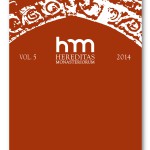Monstrancja i kielich z dawnego kościoła klasztornego reformatów w Kryłowie, obecnie w zakrystii klasztoru reformatów w Przemyślu
Monstrance and chalice from the former Reformati Monastery Church in Kryłów, currently in the sacristy of the Reformati Monastery in Przemyśl
Author(s): Janina DzikSubject(s): Fine Arts / Performing Arts
Published by: Laboratoire de Recherches sur l'Histoire des Congregations et Ordres Religieux (LARHCOR)
Keywords: Kryłów; Przemyśl; Cracow; Biecz; goldsmithing; Franciscans of the strict observance (Reformati); fr. Stanisław Dominik Kleczewski; monastic artists
Summary/Abstract: The Reformati Monastery in Kryłów near Hrubieszów was founded in the 1750s. After the dissolution of the monastery in 1808 by the Austrian authorities the monastery church was sold and dismantled and its furnishings were dispersed. The Reformati Monastery Church of St. Anthony in Przemyśl houses a valuable rococo radial monstrance made around the mid-18th century, which can be regarded as an eminent example of Polish goldsmithing. Its value is enhanced by full figures of God the Father and Apocalyptic Lamb as well as symbols of Old Testament sacrifices. The foot of the monstrance bears the inscription CONV. KRYLOVIENSIS PP. REFORM, unequivocally pointing to the place for which it was made. This may be the monstrance mentioned in the chronicle of the Kryłów monastery, which speaks of a large and beautiful monstrance made in 1760 for the local monastery church after a drawing by Fr. Stanisław Dominik Kleczewski (1714–1776). Kleczewski served as definitor, custodian and provincial of his order; he also represented the Polish Province at general chapters in Rome. In addition, he was an amateur draughtsman. The Reformati Monastery Church of St. Casimir in Cracow boasts a rococo chalice dating to the late 18th century. The inscription on the foot indicates the place for which the chalice was made: “Conventus Krylovi[ensis]”; the inscription is accompanied by letters PP RE TŁ RM. The chalice and the monstrance mentioned in the monastery chronicle may have been a set. The topic of goldsmithing of high artistic value and precise workmanship from Reformati churches in the eastern part of Poland requires further studies (other such objects include a rococo monstrance from 1770–1780 from the Reformati Monastery in Rawa Ruska, currently kept in the monastery in Biecz, and a classicist radial monstrance of unknown provenance made at the turn of the 19th century kept in the monastery of the Przemyśl Reformati). It is all the more interesting given the fact that in this religious order, particularly valuing poverty, monstrances for liturgical purposes were usually made of wood, with only the lunette holding the host being made of silver.
Journal: Hereditas Monasteriorum
- Issue Year: 2014
- Issue No: 5
- Page Range: 295-302
- Page Count: 8

